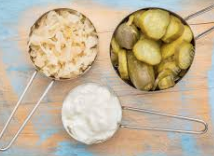SAUERKRAUT and PICKLES Multiple Choice Questions :-
1. An excessively high temperature in the fermentation of sauerkraut may inhibit the growth of
A. Leuconostoc
B. Pediococcus cerevisiae
C. both (A) and (B)
D. none of these
Answer: A
2. Which statement is true about flavouring materials spices, garlic etc. added to Dill pickles?
A. These markedly stimulate or inhibit the acid forming bacteria
B. They may be source of considerable numbers of undesirable micro-organisms and cause off-fermentations or spoilage of pickles
C. They may improve texture of the pickle
D. None of these
Answer: B
3. Shriveling in fermented pickles results from the physical effect of
A. too strong salt solution
B. too strong sugar solution
C. too strong vinegar solution
D. all of these
Answer: D
4. Gassy spoilage of green olives is usually caused by
A. Enterobacter spp
B. Bacillus spp
C. Clostridium spp
D. all of these
Answer: D
5. Abnormal fermentation of cabbage may result in a cheese like odour caused by
A. propionic acid
B. butyric acid
C. caprioc acid and Valeric acid
D. all of these
Answer: D
6. Too long a fermentation of sauerkraut may favour the growth of
A. Lactobacillus lactis
B. Lactobacillus brevis
C. Bacillus subtilis
D. none of these
Answer: B
7. Blackening in pickles occurs due to
A. the formation of hydrogen sulfide by bacteria
B. growth of Pencillium
C. both (A) and (B)
D. none of the above
Answer: A
8. Soft pickles are made so by pectolytic enzymes mostly from
A. moulds
B. yeasts
C. bacteria
D. none of these
Answer: A
9. Hollow pickles are obtained as a result of
A. loose packing in the vat
B. too strong or too weak brine
C. both (A) and (B)
D. none of these
Answer: C
10. The favouring conditions for floaters is
A. high intial amounts of salt
B. thick skin that does not allow gas to diffuse out
C. both (A) and (B)
D. none of these
Answer: C

SAUERKRAUT and PICKLES Objective type Questions with Answers
11. The growth of black-pigmented Bacillus nigrificans, a causative agent of black pickle is favoured by
A. presence of carbohydrate like glucose
B. low level of available nitrogen
C. neutral or slightly alkaline brine
D. all of the above
Answer: D
12. Black kraut is caused by
A. the plant enzymes
B. the micro-organisms
C. the combined actions of plant enzymes and micro-organisms
D. none of the above
Answer: C
13. Floaters or bloaters may result from
A. hollow cucumbers
B. gas being formed by yeasts
C. hetero fermentative lactic acid bacteria
D. all of these
Answer: D
14. Slippery pickles occur due to
A. growth of encapsulated bacteria
B. broken scums of film yeasts on the surface of brine
C. addition of high amount of salt
D. both (A) and (B)
Answer: D
15. Slimy or ropy kraut is caused by
A. encapsulated varieties of Lactobacillus plantarum
B. Lactobacillus lactis
C. encapsulated varieties of Lactobacillus brevis
D. none of the above
Answer: A
16. The most important bacterium developing acidity in both low and high salt brines is
A. L. lactis
B. L. plantarum
C. L. brevis
D. B. subtilis
Answer: B
17. The elimination of the scum of yeasts in the brine during the fermentation include
A. agitation of the surface
B. addition of the mustard oil
C. addition of the sorbic acid
D. all of these
Answer: D
18. Cloudiness of brine of glass-packed olives may be caused by
A. the lactics if fermentation of residual sugar resumes
B. salt-tolerant bacteria
C. film yeasts or moulds if air is available
D. all of the above
Answer: D